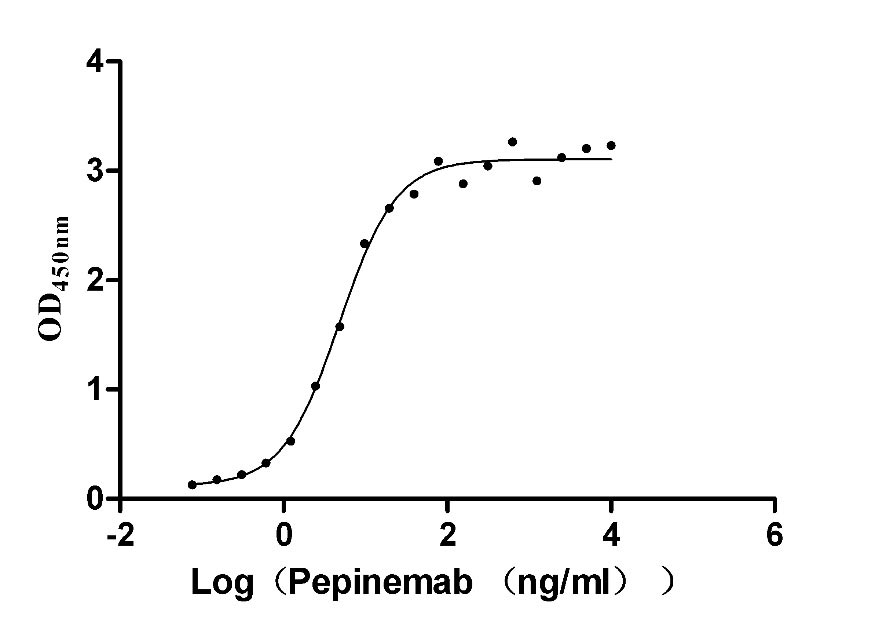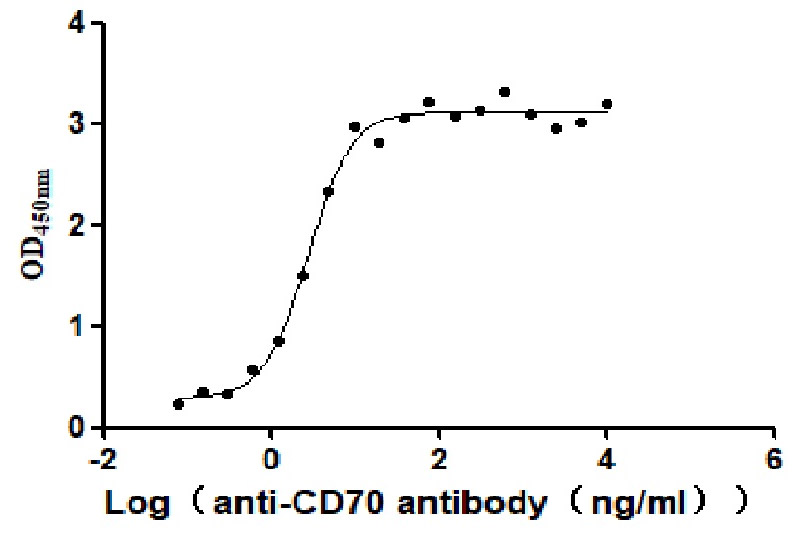Recombinant Mouse NKG2-D type II integral membrane protein (Klrk1), partial
-
中文名稱:小鼠Klrk1重組蛋白
-
貨號:CSB-YP012474MO1
-
規格:
-
來源:Yeast
-
其他:
-
中文名稱:小鼠Klrk1重組蛋白
-
貨號:CSB-EP012474MO1
-
規格:
-
來源:E.coli
-
其他:
-
中文名稱:小鼠Klrk1重組蛋白
-
貨號:CSB-EP012474MO1-B
-
規格:
-
來源:E.coli
-
共軛:Avi-tag Biotinylated
E. coli biotin ligase (BirA) is highly specific in covalently attaching biotin to the 15 amino acid AviTag peptide. This recombinant protein was biotinylated in vivo by AviTag-BirA technology, which method is BriA catalyzes amide linkage between the biotin and the specific lysine of the AviTag.
-
其他:
-
中文名稱:小鼠Klrk1重組蛋白
-
貨號:CSB-BP012474MO1
-
規格:
-
來源:Baculovirus
-
其他:
-
中文名稱:小鼠Klrk1重組蛋白
-
貨號:CSB-MP012474MO1
-
規格:
-
來源:Mammalian cell
-
其他:
產品詳情
-
純度:>85% (SDS-PAGE)
-
基因名:
-
Uniprot No.:
-
別名:Klrk1; Nkg2d; NKG2-D type II integral membrane protein; Killer cell lectin-like receptor subfamily K member 1; NK cell receptor D; NKG2-D-activating NK receptor; CD antigen CD314
-
種屬:Mus musculus (Mouse)
-
蛋白長度:Partial
-
蛋白標簽:Tag?type?will?be?determined?during?the?manufacturing?process.
The tag type will be determined during production process. If you have specified tag type, please tell us and we will develop the specified tag preferentially. -
產品提供形式:Lyophilized powder
Note: We will preferentially ship the format that we have in stock, however, if you have any special requirement for the format, please remark your requirement when placing the order, we will prepare according to your demand. -
復溶:We recommend that this vial be briefly centrifuged prior to opening to bring the contents to the bottom. Please reconstitute protein in deionized sterile water to a concentration of 0.1-1.0 mg/mL.We recommend to add 5-50% of glycerol (final concentration) and aliquot for long-term storage at -20℃/-80℃. Our default final concentration of glycerol is 50%. Customers could use it as reference.
-
儲存條件:Store at -20°C/-80°C upon receipt, aliquoting is necessary for mutiple use. Avoid repeated freeze-thaw cycles.
-
保質期:The shelf life is related to many factors, storage state, buffer ingredients, storage temperature and the stability of the protein itself.
Generally, the shelf life of liquid form is 6 months at -20°C/-80°C. The shelf life of lyophilized form is 12 months at -20°C/-80°C. -
貨期:Delivery time may differ from different purchasing way or location, please kindly consult your local distributors for specific delivery time.Note: All of our proteins are default shipped with normal blue ice packs, if you request to ship with dry ice, please communicate with us in advance and extra fees will be charged.
-
注意事項:Repeated freezing and thawing is not recommended. Store working aliquots at 4°C for up to one week.
-
Datasheet :Please contact us to get it.
相關產品
靶點詳情
-
功能:Functions as an activating and costimulatory receptor involved in immunosurveillance upon binding to various cellular stress-inducible ligands displayed at the surface of autologous tumor cells and virus-infected cells. Provides both stimulatory and costimulatory innate immune responses on activated killer (NK) cells, leading to cytotoxic activity. Acts as a costimulatory receptor for T-cell receptor (TCR) in CD8(+) T-cell-mediated adaptive immune responses by amplifying T-cell activation. Stimulates perforin-mediated elimination of ligand-expressing tumor cells. Signaling involves calcium influx, culminating in the expression of TNF-alpha. Participates in NK cell-mediated bone marrow graft rejection. May play a regulatory role in differentiation and survival of NK cells. Binds to ligands belonging to various subfamilies of MHC class I-related glycoproteins including RAET1A, RAET1B, RAET1C, RAET1D, RAET1E, H60 and MULT1.
-
基因功能參考文獻:
- Study demonstrated a novel outcome for Nkg2d in its capacity to promote rather than delay tumor progression in the context of liver carcinogenesis. PMID: 28128200
- Interaction between NKG2D and endogenous RAE-1delta desensitizes NK cells and impairs antitumor NK responses and tumor rejection. PMID: 29231815
- Results suggest that NKG2D+CD4+ T cells are involved in the pathogenesis of systemic lupus erythematosus by killing Treg cells in a NKG2D-NKG2DL-dependent manner. PMID: 28455530
- Loss of NKG2D expression accelerates rejection of cardiac allografts. PMID: 28805342
- IL-15 mediated up-regulation of the activation receptor NKG2D and its adaptor DAP10 in B-1a cells indicating their essential coupling with IL-15 receptor signaling pathway. PMID: 28235675
- NKG2DL low expressing cancer cells formed palpable allogeneic tumors in mice within a week after the inoculation, while NKG2DL high expressing cancer cells failed to proliferate and were prevented from forming tumors. PMID: 27448968
- NKG2D is upregulated, and ROS and caspase-3 are inhibited by Strongylocentrotus nudus egg polysaccharide-enhanced antitumor 5-FU in mice PMID: 27385218
- High NKG2D expression is associated with the Development of Bronchiolitis Obliterans. PMID: 28251796
- tumoral NKG2D stimulates cell propagation and immune escape in acute myeloid leukemia cells PMID: 26740330
- The authors observed that the mouse cytomegalovirus encoded protein m18 is necessary and sufficient to drive expression of the RAE-1 family of NKG2D ligands. RAE-1 is transcriptionally repressed by histone deacetylase inhibitor 3 (HDAC3) in healthy cells, and m18 relieves this repression by directly interacting with Casein Kinase II and preventing it from activating HDAC3. PMID: 27874833
- proposed that TLR9 regulates the NF-kappaB-NLRP3-IL-1beta pathway negatively in Salmonella-induced NKG2D-mediated intestinal inflammation and plays a critical role in defense against S. typhimurium infection and in the protection of intestinal integrity. PMID: 28576980
- NKG2D-deficient mice and mice constitutively expressing NKG2D ligands had increased incidence of B cell tumors, confirming that the inability to clear NKG2D ligand-expressing cells was important in tumor suppression and that NKG2D ligand expression is a marker of nascent tumors PMID: 27183590
- data show that NKG2D has a nonredundant role in priming of CD8(+) T cells to produce antiviral cytokines PMID: 28378389
- NKG2D augments Ly49H-dependent proliferation of NK cells; however, NKG2D signaling alone is inadequate for expansion of NK cells, likely due to only transient expression of the NKG2D-DAP12 complex PMID: 28760883
- study demonstrates that the effect of NKG2D on B1a cell development occurs at a developmental stage that precedes the common lymphoid progenitor; findings reveal an unexpected new role for NKG2D in the regulation of B1a cell development PMID: 28087665
- Sirt6 binds to promoters of NKG2D ligand genes and regulates the H3K9 and H3K56 acetylation levels PMID: 27045575
- These results support the conclusion that svH1C mimics Neu5Ac-containing sequences and interacts with cell-surface receptor NKG2D, which contains a lectin-like domain PMID: 26110603
- These results indicate that, unlike in the pancreas, NKG2D-NKG2D ligand interaction does not play a critical role in obesity-induced inflammation in the adipose tissue. PMID: 25333972
- The results show that NK cells and the NKG2D receptor play a role in control of lymphomas, and that selection of NKG2D-ligand (MULT1) loss mutants provides a mechanism for tumor escape. PMID: 26151313
- these data support a novel role for NKG2D expression by CD8(+) T cells during allogeneic HSCT, which could be potentially therapeutically exploited to separate GVHD from GVT effects. PMID: 25788701
- NKG2D and NKG2DL are involved in allergen-induced activation of dendritic epidermal T cells and the NKG2D/NKG2DL pathway might be a potential target for treatment of contact hypersensitivity. PMID: 25634359
- Viral infection of cultured cells increased RAE-1 expression, resulting in enhanced NK cell-mediated killing through NKG2D recognition. PMID: 24898518
- Activation through the NKG2D receptor leads to the differential activation of the NF-kappaB signaling pathway and potentially enhances the anti-tumor and anti-viral functions of effector CD8(+) T cells. PMID: 25089028
- Desiccating stress-induced chemokine expression in the epithelium is dependent on upregulation of NKG2D/RAE-1 and release of IFN-gamma in experimental dry eye. PMID: 25288568
- Highly target-specific liver NKT cells selectively remove activated hepatic stellate cells through an NKG2D-Rae1 interaction to ameliorate liver fibrosis after IL-30 treatment. PMID: 25351459
- a protective role of NKG2D-activated natural killer cells in coxsackievirus B3 myocarditis leading to an effective virus clearance PMID: 24797160
- bystander memory CD8 T cells can participate in an unrelated immune response and induce immunopathology through an NKG2D dependent mechanism without providing increased protection. PMID: 24586170
- Doxorubicin plus IL-12 induces NKG2D in CD8+T cells in vivo and boosts NKG2D+CD8+T-dependent antitumor immune surveillance PMID: 24565056
- NKG2D ligation relieves 2B4-mediated NK-cell self-tolerance in mice. PMID: 24610736
- the induction of retinoic acid early transcript 1 (RAE1) ligands for NKG2D by the DDR relies on a STING-dependent DNA sensor pathway involving the effector molecules TBK1 and IRF3. PMID: 24590060
- Cigarette smoke - induced airway injury stimulates toll-like receptor signaling by endogenous nucleic acids leading to elevated NKG2D ligand expression. PMID: 24130907
- CD4(+) NKG2D(+) T cells induce NKG2D down-regulation in natural killer cells in CD86-RAE-1epsilon transgenic mice. PMID: 24708417
- The absence of NKG2D signaling in natural killer cells significantly improves neural progenitor cell-derived neuron survival and differentiation. PMID: 23733329
- studies established a pivotal role for NK-cell NKG2D and granzyme B in the pathogenesis of house dust mite-allergic lung disease, and identified novel therapeutic targets for the prevention and treatment of asthma. PMID: 24290277
- NKG2D can function as a coactivating stress receptor that directly triggers cytotoxicity in dendritic epidermal T cells. PMID: 23962808
- The severity of experimental autoimmune encephalitis was decreased in NKG2D-deficient mice. PMID: 24211717
- NKG2D enhances IL-15-mediated Phosphatidylinositol 3-Kinase signaling of activated CD8 T cells, in a specific phase of memory cell commitment, after activation but before terminal differentiation. PMID: 23804716
- NKp46 deficiency alone, or in combination with NKG2D deficiency, had no effect on frequency or function of NK cells PMID: 23649470
- cytotoxic potential of NK cells against a wide spectrum of tumor subtypes could be markedly enhanced by expression of NKG2D-DAP10-CD3zeta receptors PMID: 23302231
- The engagement of NKG2D by its ligand (Rae-1) elicits not only target cell lysis, but also natural killer cell fratricide. PMID: 23690625
- The constitutive levels of NKG2D ligand expression on IECs are regulated by microbial signaling in the gut. PMID: 23136011
- NKG2D is expressed by all natural killer (NK) cells but is not limited to NK cells, as it is also expressed by many T cells, including all activated CD8+ T cells in mice, subsets of gammadelta T cells, and subsets of NKT cells. PMID: 23298206
- Mouse tumor vasculature expresses NKG2D ligands and can be targeted by chimeric NKG2D-modified T cells. PMID: 23355740
- Simultaneous knockdown of multiple ligands of NKG2D prevents natural killer cell-mediated fulminant hepatitis. PMID: 22806577
- wound healing was delayed in mice lacking NKG2D PMID: 23166357
- NKG2D-mediated, but not Fc receptor-mediated, recognition increases natural killer (NK) cell degranulation; only NKG2D engagement substantially enhances degranulation. PMID: 23183896
- The expression of any of the murine ligands for the NK-cell activating receptor NKG2D results in a concomitant reduction in MHC class I expression. PMID: 22740149
- IL-4-induced innate CD8 T cells do not express NKG2D (or CCL5). PMID: 22942430
- NKG2D has no major role in the generation and expansion of memory CD8 T cells, but rather substantially enhances the cytolytic effector responses of reactivated memory T cells and thereby contributes to an efficacious tumor rejection. PMID: 21607945
- Upregulation of NKG2D ligands by H-RasV12 increased sensitivity of cells to NK cell-mediated cytotoxicity PMID: 22798674
顯示更多
收起更多
-
相關疾病:Involved in autoreactive CD8(+) T-cell-mediated development of autoimmune diabetes.
-
亞細胞定位:Cell membrane; Single-pass type II membrane protein. Note=Colocalized with HCST and TYROBP on the cell surface.
-
組織特異性:Expressed in natural killer (NK) cells, activated CD8(+) alpha-beta and gamma-delta T-cells and natural killer T (NKT) cells (at protein level). May be expressed on dendritic cell (DC). Isoform 1 is strongly expressed in natural killer (NK) cells. Isoform
-
數據庫鏈接:
Most popular with customers
-
Recombinant Human Semaphorin-4D (SEMA4D), partial (Active)
Express system: Mammalian cell
Species: Homo sapiens (Human)
-
Recombinant Human CD70 antigen (CD70), partial (Active)
Express system: Mammalian cell
Species: Homo sapiens (Human)
-
Recombinant Human Tumor necrosis factor ligand superfamily member 15(TNFSF15) (Active)
Express system: Mammalian cell
Species: Homo sapiens (Human)




-AC1.jpg)









